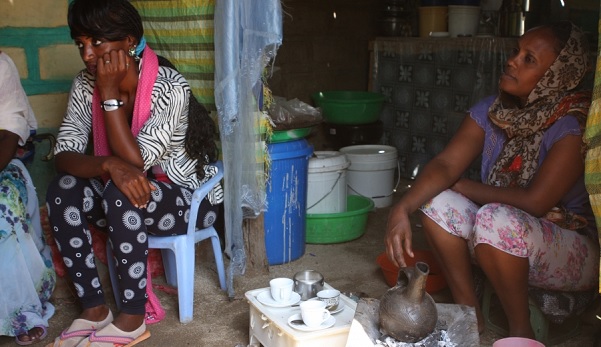
Each night along the 567-mile shared border, Eritreans move through the hilly terrain out of sight of their own military to escape into Ethiopia.
By James Jeffrey (PRI) |
Sand and grime surround the drooping eyelids of a tired 14-year-old Eritrean girl in a dirty pink tracksuit who spent the night crossing from Eritrea into the enemy territory of Ethiopia.
She carries a single plastic bag containing a few pieces of clothing, an orange cup and a small flashlight. Its batteries are almost dead. Beside her are four men, three women and five younger children, all of whom having crossed were picked up by Ethiopian military before being dropped off at a governmental compound in the town of Adinbried.
Simple buildings mark the beginning of the bureaucratic and logistical process of assigning them asylum status before finally moving them to one of four refugee camps designated for Eritreans in Ethiopia’s northern Tigray region.
“He was good,” a 31-year-old man in the group says about the smuggler they each paid $2,500 to get them across. “He showed us the safe paths, and helped carry the children on his shoulders. He didn’t ask for more money like some do.”
Each night along the 567-mile shared border, Eritreans move through the hilly terrain out of sight of their own military to escape into Ethiopia.
Previously, the Eritrean military employed a shoot-to-kill policy, but it’s reportedly less rigorously enforced now as discontent and sympathy spread in the military.
“Our wives didn’t want us to go and were too scared to come,” says a 39-year-old Eritrean former soldier — now deserter — who crossed the border with two other soldiers. “But they’re not angry with us. Whether we are in national service or Ethiopia they still can’t see us.”
An open door to Eritreans
In February 2017, 3,367 Eritrean refugees arrived in Ethiopia, according to the Ethiopian Administration for Refugee and Returnee Affairs (ARRA), many fleeing the likes of enforced indefinite military service, illegal imprisonment and torture.
There are now about 165,000 Eritrean refugees and asylum-seekers currently living in Ethiopia, according to the United Nations.
Read the complete story at PRI
——
See also:
- VIDEO: An Eritrean in Ethiopia: Teddy Love’s Story
- World Bank Funds 100mln USD for Refugees Project in Ethiopia
- Caritas Italiana, Migrantes Foundation Build Humanitarian Aid Corridor in Ethiopia
- EU, Netherlands Launch Innovative Regional Development and Protection Program (RDPP) in Ethiopia for Refugees
